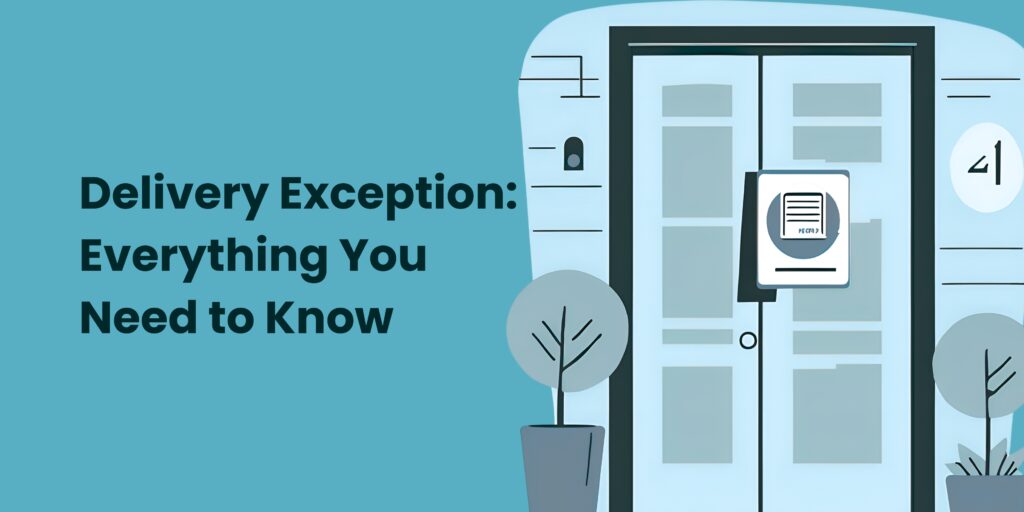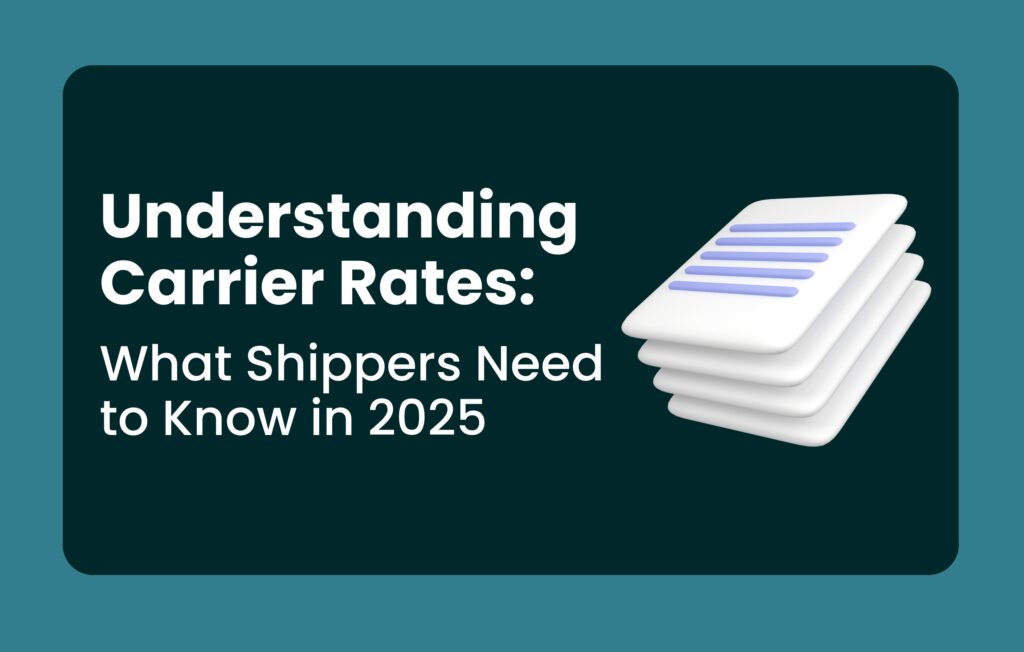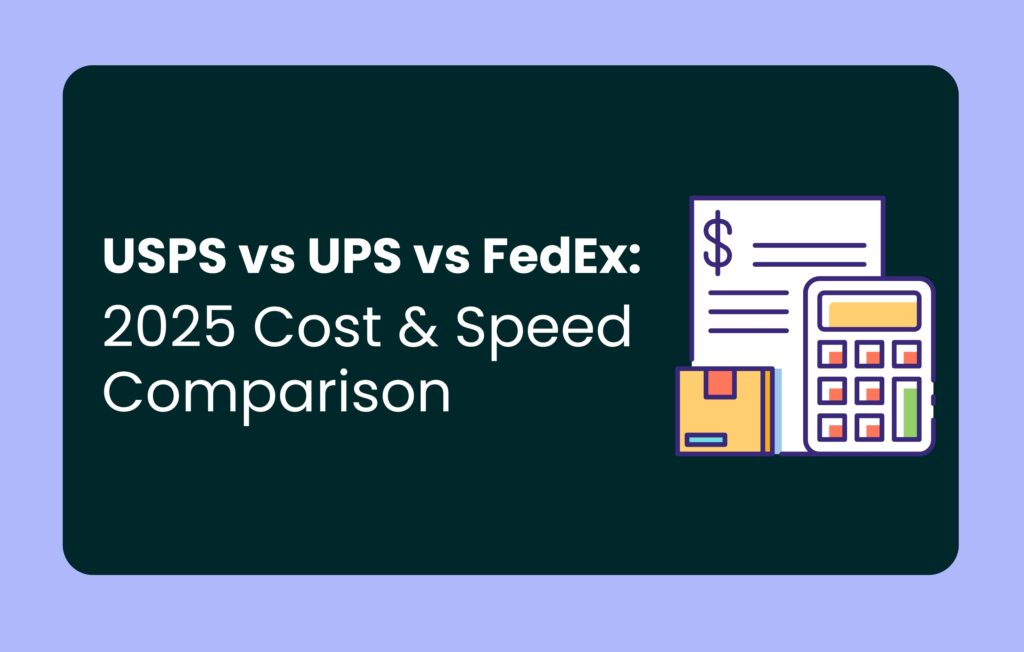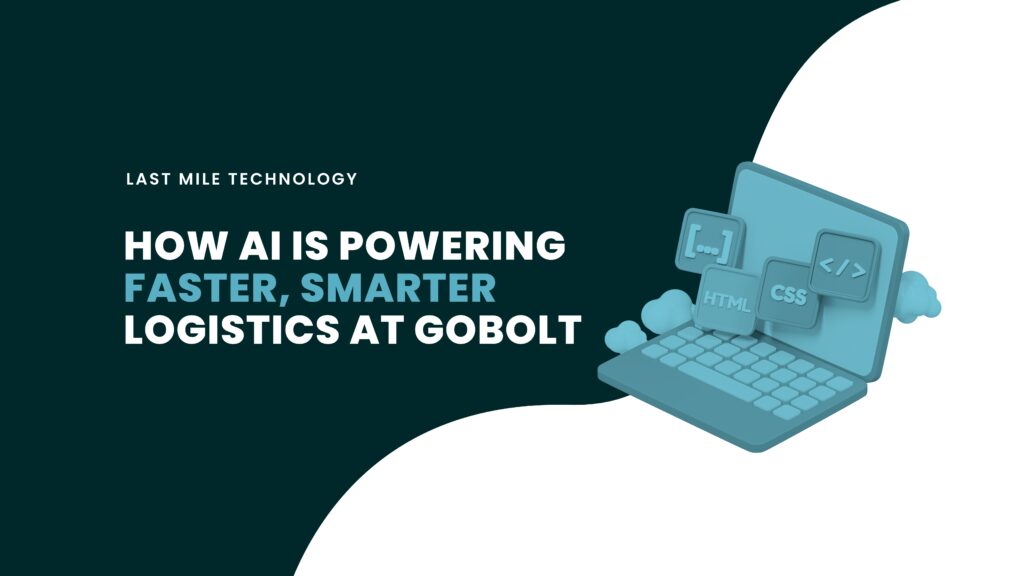A delivery exception that puts the arrival of a package up in the air is never ideal. The completion of a fast, smooth delivery is especially crucial at a time when quick shipping times are key to shopper satisfaction. According to McKinsey, if delivery times are too lengthy, almost 50% of shoppers will take their business elsewhere.
Although delivery exceptions have improved across the industry, dropping to a 5.9% issue rate in 2023, a 13.5% improvement from the previous year, they remain an unavoidable part of logistics.
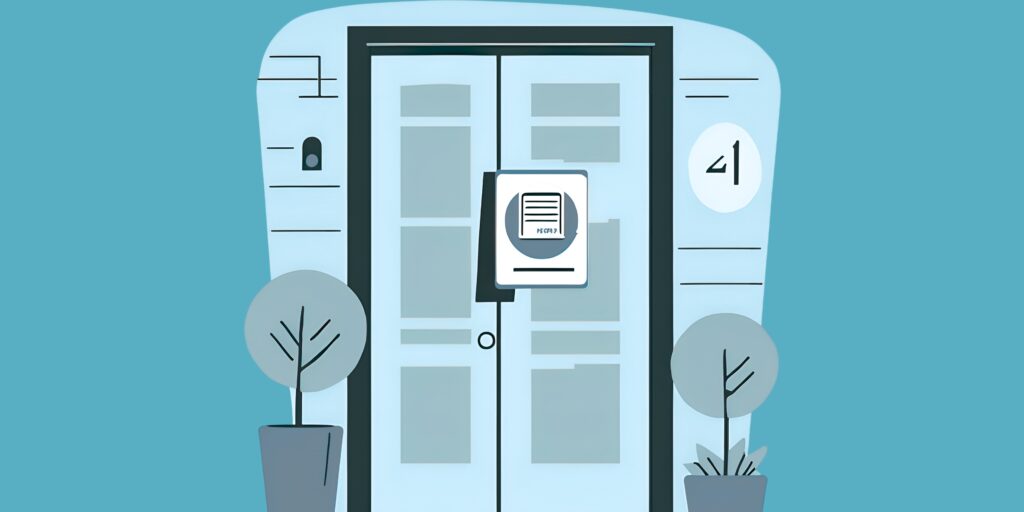
In this guide to delivery exceptions, we’ll cover:
Introduction to Delivery Exceptions
Delivery exceptions refer to any unforeseen events or circumstances that disrupt the normal delivery process of a package. These exceptions can occur due to various reasons, including incorrect addresses, weather-related delays, customs issues, or other unforeseen conditions. Understanding delivery exceptions is critical for brands and shoppers who rely on timely and reliable shipping services.
When a delivery exception occurs, it means that the package’s journey has been temporarily interrupted, and additional steps are needed to resolve the issue. For instance, an incorrect address might require the carrier to contact the recipient for clarification, while severe weather conditions could make certain delivery routes unpassable. These interruptions can lead to delays, but they don’t necessarily mean that the package won’t be delivered.
By understanding the common causes of delivery exceptions and how to address them, brands can better manage shopper expectations and improve overall satisfaction.
What is a Delivery Exception?
A delivery exception is when a package is temporarily held up in transit for some time due to unexpected reasons. A delivery exception indicates that at some point during the delivery process, the progression of the package was halted and additional steps or attention were needed to resolve the situation.
No one likes to see that their package has had a delivery exception. While this term often triggers concern among shoppers, it’s important to understand that a delivery exception doesn’t always mean a delayed or undelivered package. After experiencing an exception, parcels may still arrive at their destinations safely and on time. Such events can include natural disasters and other unforeseen circumstances.
Delivery exceptions serve as flags in the delivery system, alerting carriers and brands that intervention might be necessary to ensure successful delivery.
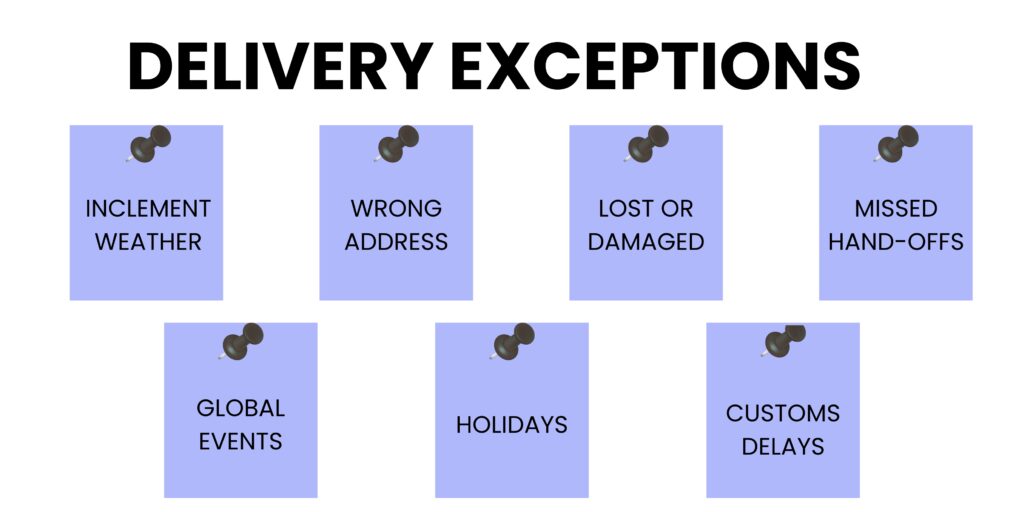
Why Do Delivery Exceptions Happen?
Delivery interruptions happen for a whole host of reasons, many of which are beyond the control of brands or carriers themselves. In recent years major couriers from Canada Post to FedEx to UPS all had to adjust their messaging around deliveries to reflect possible service interruptions.
Providing customers with status updates is crucial to keep them informed about delivery exceptions, ensuring transparency and trust through multi-channel communication strategies like email, SMS, and automated notifications.
Here are a few of the instances that can lead to delivery exceptions:
1. Inclement weather
One of the most common and unavoidable reasons for a delivery exception is severe weather conditions.
Extreme weather events, like blizzards, hurricanes, floods, or wildfires can lead to impassible routes, making package deliveries dangerous or simply impossible. Adverse weather conditions can lead to delivery exceptions. These weather-related exceptions can impact both ground transportation by trucks and overseas deliveries by air or ship.
During the 2023 holiday season, UPS reported weather-related delay rates as high as 7.82%, demonstrating how seasonal conditions can disrupt even the most established delivery networks.
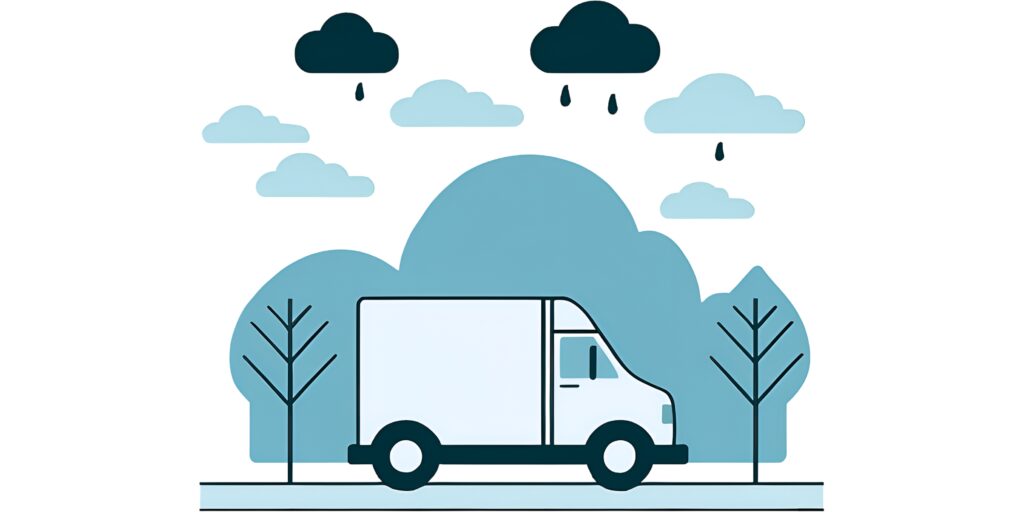
2. Issues with a shipping address
Address-related problems account for a significant portion of delivery exceptions. Trouble reaching a recipient’s address can happen when the delivery address is incorrect, incomplete, unclear or inaccessible by delivery personnel. Incorrect address information can lead to delivery exceptions, causing delays and additional costs for businesses.
Common address problems include:
- Missing apartment numbers
- Incorrectly entered street names
- Outdated addresses from shoppers who have recently moved
For internationally shipped items, address verification becomes even more critical, as formatting differences between countries can lead to confusion.
On top of this, international shipments face unique exceptions: packages can be held at customs for extended periods, and extra documentation may be required but missing, leading to further delays.
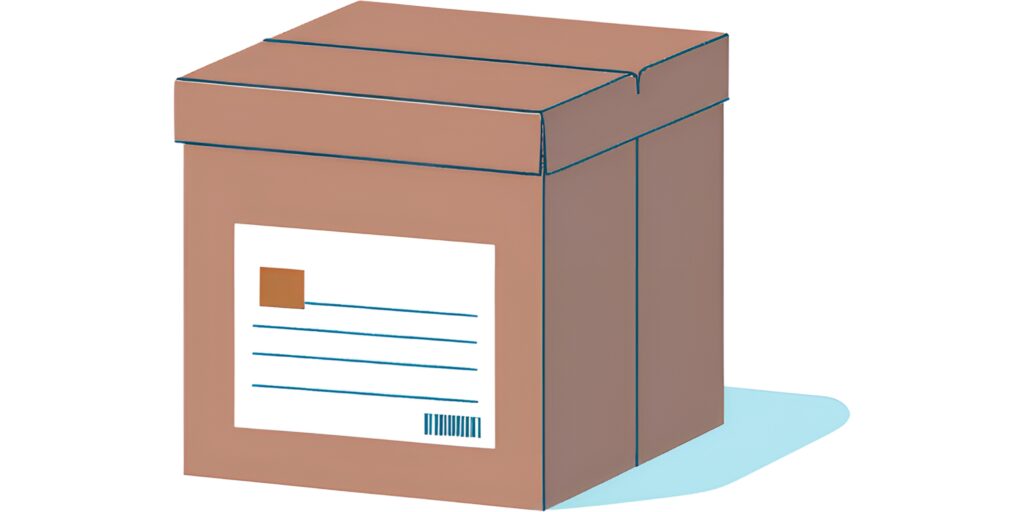
3. Lost or damaged orders
Perhaps the most concerning type of delivery exception involves packages that cannot be located by the carrier or have sustained damage during the shipping process. Despite advanced tracking technologies, packages can still go missing during sorting, transfer between vehicles, or delivery attempts. Damaged packages can also lead to delivery exceptions, impacting customer satisfaction and brand reputation.
Similarly, improper handling, inadequate packaging, or accidents during transportation can result in damaged goods. Most major couriers will cover the damages or losses up to $100 in value. You can also purchase additional shipping insurance to ensure that you’re covered.
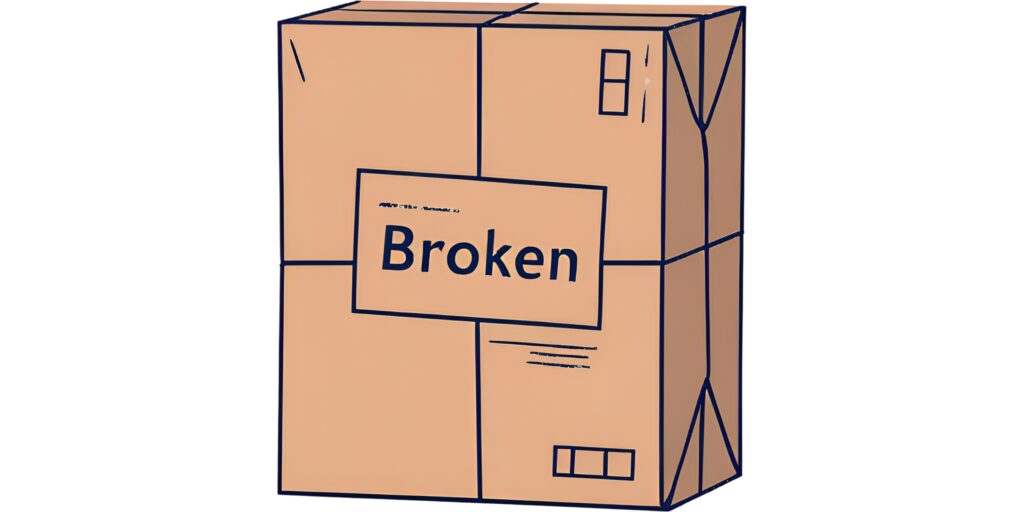
4. Missed hand-offs
Failed delivery attempts represent another common trigger for exceptions. This typically occurs when a package requires a signature but the recipient isn’t available during the delivery window. Without a signature, carriers cannot complete the delivery and must either attempt delivery again or hold the package for pickup.
The rise in porch theft has led more merchants to require signatures for valuable items, increasing the likelihood of missed hand-offs. This is why proactive communication between a brand, their 3PL, and the shopper is critical. Last mile delivery tracking, including updates via email and SMS, help to ensure recipients know when to expect their deliveries, reducing the chance of unsuccessful delivery attempts.
5. Global events
Major global events can dramatically impact the entire supply chain, creating widespread delivery exceptions across different product categories. Global disruptions like geopolitical conflicts, major strikes, workforce shortages, or fuel shortages can similarly affect delivery reliability and timing.

6. Holidays
During peak shopping seasons like Black Friday, Cyber Monday, and the December holiday period, delivery networks experience extraordinary volume surges that can strain capacity.
When national or international holidays fall within a shopper’s shipping window, delays naturally occur as many sorting facilities and delivery services operate with reduced staff or close completely. Additionally, a national holiday can impact the scheduling and efficiency of package deliveries, as carriers may not operate, leading to significant delays in shipping due to backlogs created by the day off.
7. Customs Delays
Customs delays can occur when international shipments are held up due to regulatory issues, missing documentation, or other customs-related problems. These delays are particularly common in international shipping, where packages must pass through customs checks before reaching their final destination.
To prevent customs delays, it is essential to ensure that all necessary documentation is complete and accurate. This includes providing detailed descriptions of the contents, proper valuation, and any required certificates or permits. Compliance with all relevant regulations is also crucial to avoid any hold-ups.
Working with a reputable shipping carrier that has experience with international shipments can significantly reduce the risk of customs delays. These carriers are often well-versed in the complexities of international shipping and can help navigate the regulatory landscape more efficiently. By taking these steps, businesses can minimize the impact of customs delays and ensure a smoother delivery process for their international shipments.

How Different Carriers Handle Delivery Exceptions
Understanding how major carriers manage delivery exceptions can help brands better communicate with shoppers and set appropriate expectations. Each carrier has its own protocols and systems for handling these situations.
Using multiple carriers can enhance reliability and mitigate risks associated with relying on a single provider.
FedEx delivery exception
For weather-related delays, FedEx may reroute packages through alternative hubs or hold them until conditions improve. With address issues, they attempt to contact the recipient directly for clarification and may make multiple delivery attempts. For international shipments facing customs delays, FedEx works to resolve documentation issues promptly, though resolution times vary depending on the complexity of the customs requirements.
Having a FedEx tracking number readily available is crucial for efficiently tracking shipments and providing updates to customers in case of delivery exceptions. This tracking number is essential for monitoring the shipment’s status and resolving any issues that arise during transit.
FedEx typically attempts to resolve most domestic exceptions within 24-48 hours, prioritizing urgent or time-sensitive shipments when possible.
UPS delivery exception
When encountering unknown addresses, UPS will verify and attempt to correct the information by contacting either the sender or recipient. For packages requiring signatures, UPS typically attempts redelivery or holds the package for pickup at a nearby UPS location if the initial delivery fails.
UPS generally resolves most domestic exceptions within 1-2 business days, though this timeline may extend during peak seasons. Additionally, UPS may face regulatory delays that can impact delivery times, especially for international shipments where security concerns or issues at borders can lead to unexpected delivery exceptions.
USPS
USPS observes all federal holidays, which can impact delivery schedules. For address issues, USPS attempts correction but may return packages to senders if addresses cannot be verified. USPS may also face weather delays that can impact delivery schedules. During severe weather, packages may be held at local facilities until conditions improve.
Resolution times for USPS exceptions typically range from 1-3 business days for domestic shipments, though international exceptions may take significantly longer due to customs processes.
GoBolt’s Approach
GoBolt’s exception management system includes:
- Real-time communication between drivers and dispatch
- Proactive exception alerts sent directly to brand partners and shoppers
- Dedicated team operating 7 days a week
- Sustainability-focused rerouting that minimizes carbon footprint when exceptions occur
GoBolt also provides customers with real-time delivery status updates, ensuring they are always informed about their delivery.
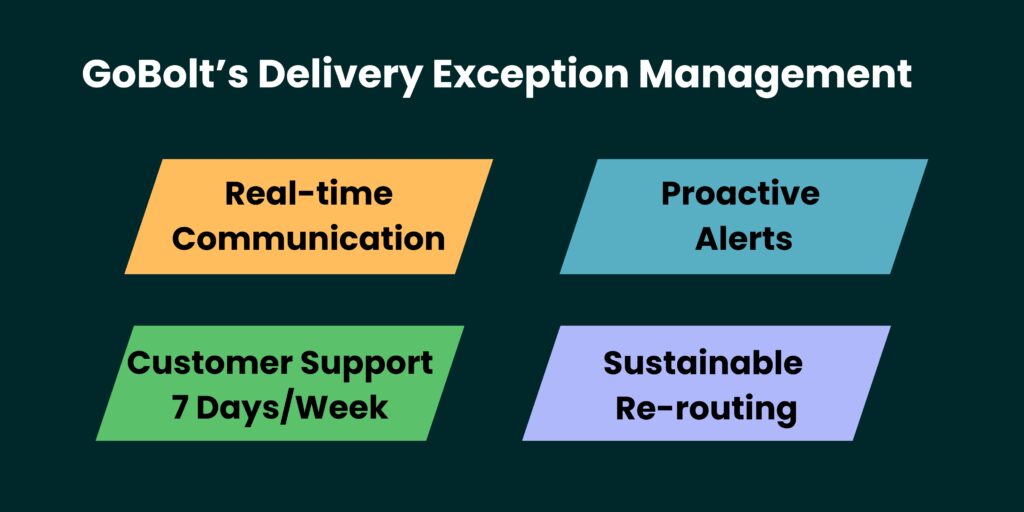
What to do when you encounter a delivery exception
When a delivery exception occurs, taking prompt action can help resolve the issue faster and improve shopper satisfaction.
Here’s a step-by-step guide for both brands and shoppers:
For brands:
- Monitor shipments proactively: Use tracking systems to identify exceptions early, before shoppers report problems.
- Contact the carrier: Reach out to the carrier’s customer service for detailed information about the exception and potential resolution timelines.
- Communicate with shoppers promptly: Notify affected shoppers about the exception, explain the cause if known, provide updated delivery estimates, and outline any next steps.
- Offer solutions and alternatives: Depending on the situation, consider offering reshipment options, store credit, or alternative delivery arrangements to maintain shopper satisfaction.
- Document the exception: Record all details about the exception for future reference and to identify any patterns that might indicate systematic issues.
- Follow up until resolution: Continue monitoring the shipment until it’s successfully delivered or an alternative solution is implemented.
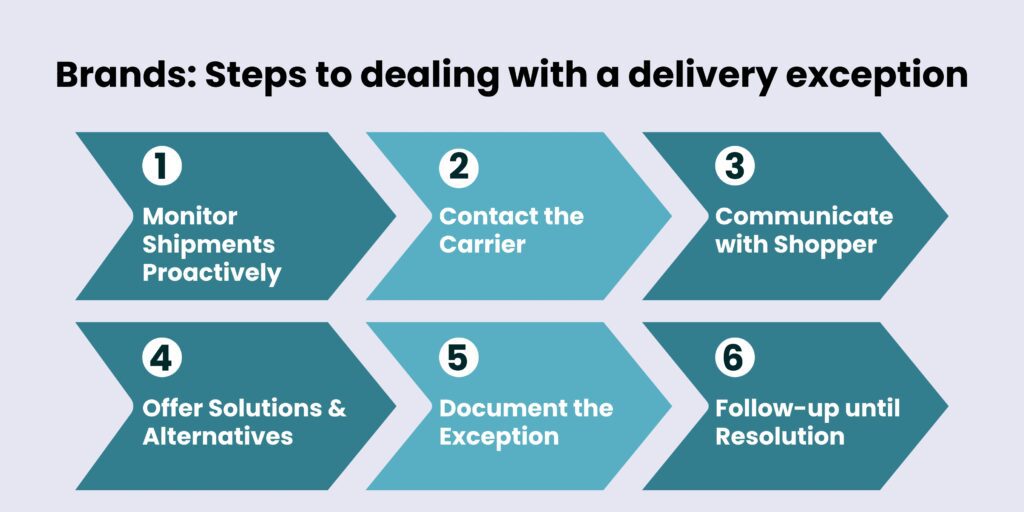
For shoppers:
- Check tracking information: Review the detailed tracking history to understand the nature of the delivery exception.
- Verify your address information: Ensure all address details are correct, especially apartment numbers or special delivery instructions.
- Contact the seller: Reach out to the brand’s customer service team for clarification and to learn what steps they’re taking to resolve the issue.
- Be available for redelivery: If the delivery exception was due to a missed delivery attempt, try to be available during the next scheduled attempt or consider alternative delivery options.
- Check with neighbors: For “delivered” statuses with missing packages, check with neighbors who might have received the package by mistake.
- Contact the carrier directly: For certain exceptions, speaking directly with the carrier’s customer service may provide additional information or expedite resolution.
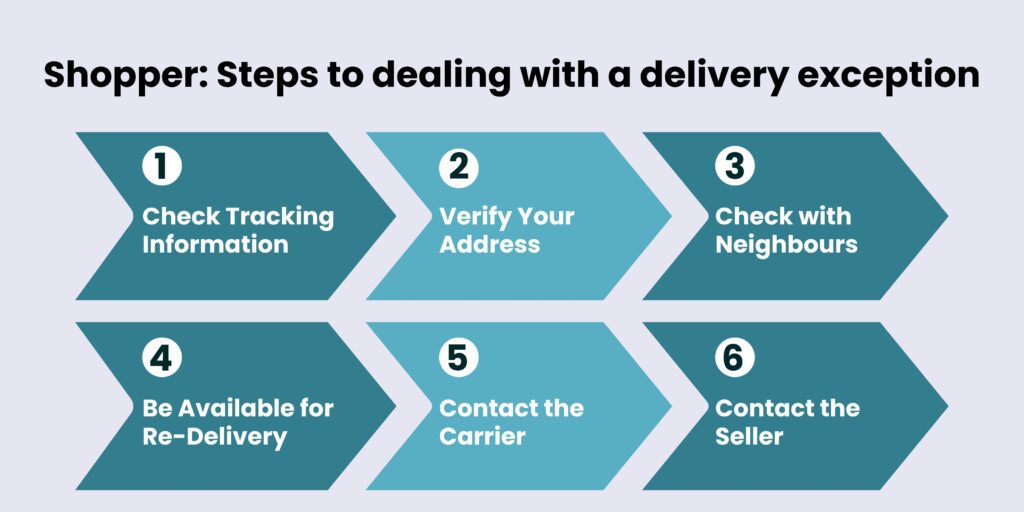
What Impact Do Delivery Interruptions Have on Brands?
Delivery exceptions can significantly impact both brands and shoppers in several important ways:
Delivery exceptions can lead to decreased customer satisfaction. Issues like late deliveries often result in consumer frustration, negative experiences, and ultimately harm customer loyalty and brand reputation.
1. Inventory management challenges
Delivery exceptions disrupt inventory management by creating discrepancies between expected and actual inventory levels. When orders encounter exceptions that result in returns to the warehouse, inventory systems may not immediately reflect these changes, leading to potential overselling or incorrect stock counts.
Implementing quality control measures can help prevent delivery exceptions.
2. Resource allocation strain
Addressing delivery exceptions requires significant operational resources. Customer service teams often need to devote considerable time investigating exception causes, communicating with affected shoppers, and coordinating with shipping partners.
3. Shopper satisfaction and brand reputation impact
Perhaps most critically, delivery exceptions directly affect customer satisfaction and brand loyalty. When shoppers don’t receive their orders as expected, their perception of the brand can suffer significantly.
Delivery exceptions can lead to damaged brand reputation, eroding customer trust and negatively impacting long-term sales and revenue.
How to GoBolt Minimize’s Delivery Exceptions
Despite best efforts, delivery exceptions can happen. What really counts is how your last mile carrier or 3PL partner responds to these situations when they do happen. Advanced tracking technologies can help minimize delivery exceptions by providing real-time visibility and proactive issue identification.
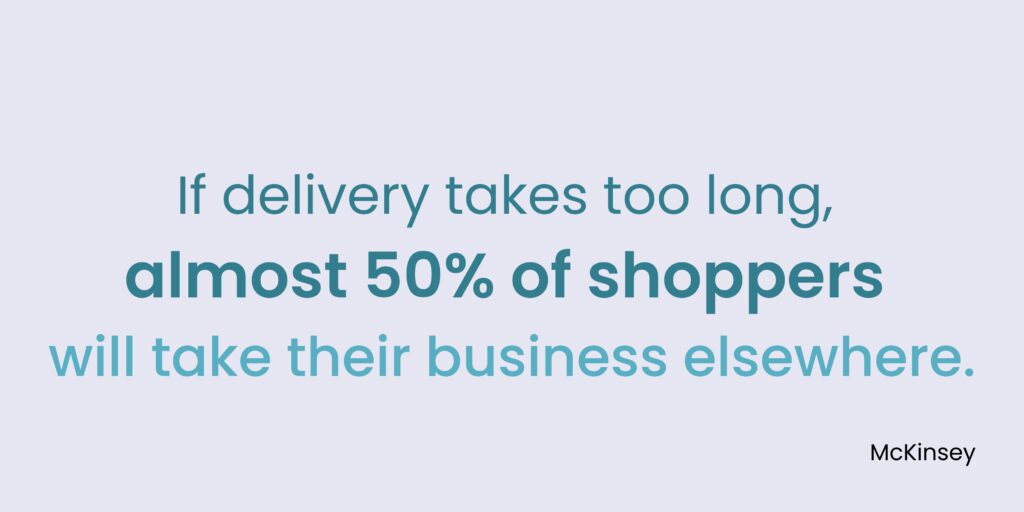
Here are ten ways to minimize shipping and delivery delays:
1. Last mile delivery tracking
Last mile delivery tracking plays a crucial role in improving delivery delays and exceptions by providing transparency, accountability, and proactive communication throughout the shipping process. Accurate address information is crucial to ensure packages reach their intended destination.
Here’s how last mile tracking helps with delivery exceptions:
2. Accurate address verification
Your shipping partner should ensure that shopper addresses are verified and accurate before dispatching orders. Implement address validation tools or software to minimize errors. An incorrect or incomplete address provided by the customer can lead to delivery exceptions.
With GoBolt’s technology, shoppers can verify their delivery addresses and make adjustments to their address up right up until their delivery route has started. This feature is intended to reduce failures due to deliveries to the wrong address.
3. Clear communication
Providing clear delivery instructions to your shipping or delivery partners is essential. Make sure they understand specific customer delivery requirements and any potential obstacles that they may encounter, such as stairs or elevators.
4. Efficient route planning
Optimize delivery routes to minimize transit time and reduce the chances of delays or missed deliveries. Utilize route planning software, like GoBolt’s route optimization software, to streamline the process. Additionally, technology failures, such as malfunctioning scanners and tracking systems, can impact the delivery process, so implementing redundant systems and robust e-commerce platforms is crucial.
5. Proactive communication
Monitor shipments throughout the delivery process and proactively address any potential issues or delays. Implement alerts for exceptions such as delays, route diversions, or failed delivery attempts. At GoBolt, brands can work with our Strategic Account Management team and Customer Support teams to monitor shipments and promptly resolve any issues.
6. Sweat the small stuff
Regardless of what mishap led to the delivery delay, GoBolt’s Customer Service team is on it. As part of our core values, we ‘sweat the small stuff’. Delivery exceptions can lead to customer dissatisfaction, so addressing them promptly is crucial.
We actively monitor and encourage shopper feedback on their delivery experience. This is an efficient way for us to identify areas for improvement and implement necessary changes. If something hasn’t gone exactly the way the shopper expected it would go, we take swift action to ensure the situation is resolved to their liking.

7. Flexible delivery options
Offering shoppers flexible delivery options, such as timed slots or delivery windows, alternative delivery locations, or delivery to a nearby pickup point, can help accommodate preferences and reduce the likelihood of missed deliveries. Delivery exceptions can lead to lost sales, as customers may choose competitors if their delivery expectations are not met.
With GoBolt’s technology, we unshackle shoppers from long delivery windows. Our SMS and email notifications will keep them informed every step of the way.

8. Use of reliable and diversified carriers
GoBolt takes a multi-carrier approach, partnering with reliable last mile carriers for delivery services. We rely on carriers with a proven track record of on-time deliveries to reduce shipment exceptions. Delivery exceptions can lead to late delivery, which is why managing customer expectations is crucial.
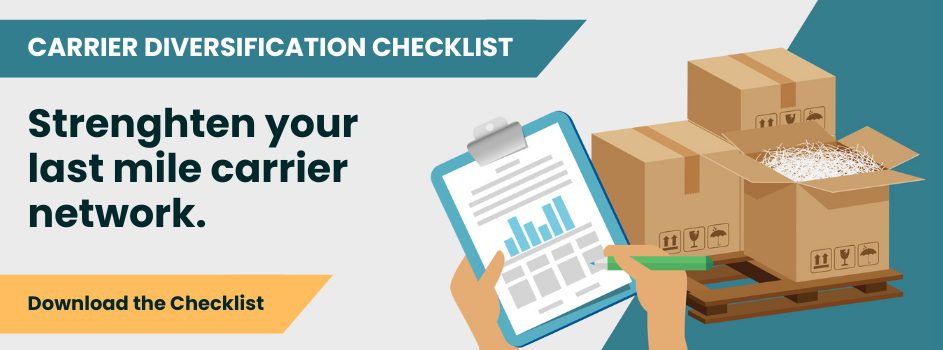
Frequently Asked Questions
Will my package still arrive if there’s a delivery exception?
In most cases, yes. A delivery exception signals a temporary delay or issue, not necessarily a failed delivery. The majority of packages experiencing exceptions are still delivered successfully, though possibly later than the original estimated delivery date.
What should I do if my package has a delivery exception?
First, check the tracking information for details about the shipment exception cause. Contact the brand’s customer service team for assistance and information about next steps. For signature-required deliveries with failed attempts, arrange to be available during redelivery or request an alternative delivery option.
How long do delivery exceptions usually last?
Resolution times vary based on the exception type and carrier. Minor issues like missed delivery attempts typically resolve within 1-2 business days. Delivery exceptions can be temporarily delayed due to various factors, such as weather or address problems. Weather-related delays may last until conditions improve, usually 2-5 days. Customs or international shipping exceptions can take longer, sometimes 1-2 weeks for complex cases.
Can I prevent delivery exceptions?
While some exceptions (like weather events) are unavoidable, you can reduce the likelihood of delivery exceptions by: providing complete and accurate address and delivery information, including apartment numbers and delivery instructions; being available to receive packages requiring signatures; considering alternative delivery locations for secure delivery; and choosing appropriate shipping options based on your timeline and the current season. Common exceptions can be managed effectively to minimize their impact.
Conclusion: Taking control of delivery exceptions
Delivery exceptions are mostly unavoidable occurrences that come up every now and then.
When exceptions do occur, the difference between a disappointed shopper and a loyal advocate often comes down to how the situation is handled. Transparent communication, proactive problem-solving, and clear expectations management transform potential frustrations into opportunities to demonstrate exceptional service.


